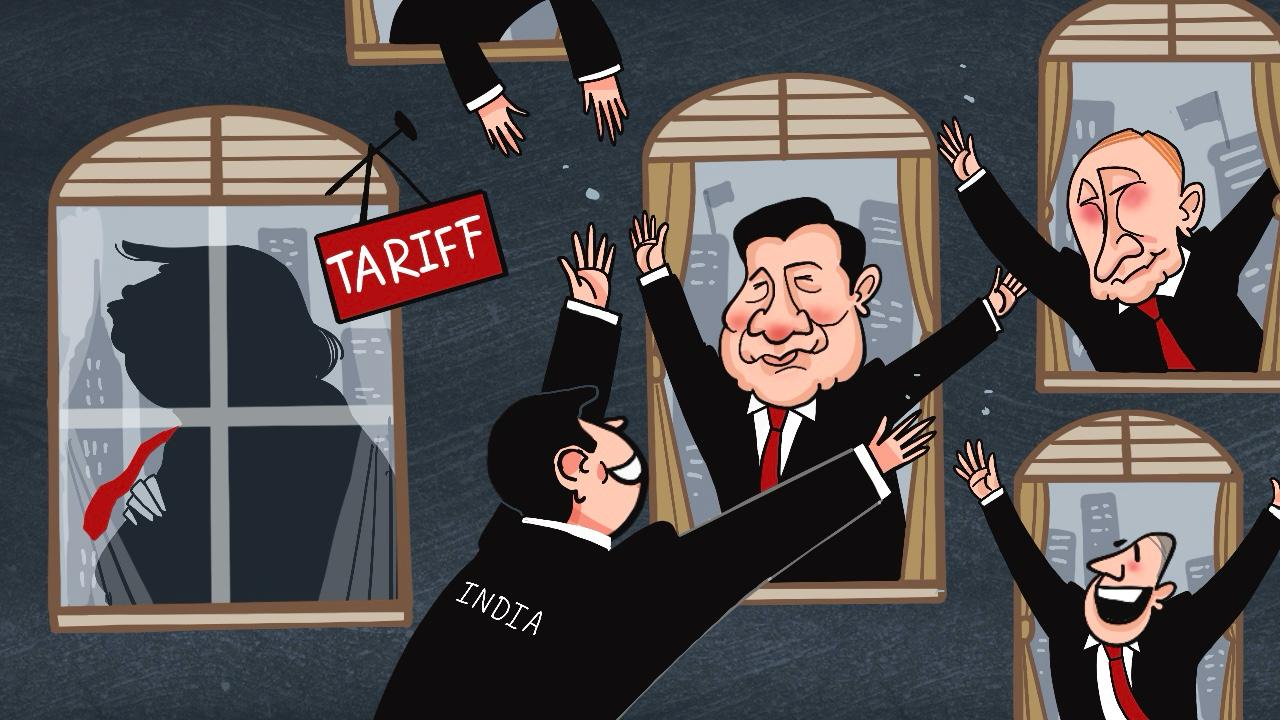President Trump singled out India by imposing additional tariffs as a special punishment. This dishonour and vindication has built India into more muscular and resilient nation.
Published Sep 24, 2025 | 8:37 AM ⚊ Updated Sep 24, 2025 | 8:37 AM

India has shifted from non-alignment to multi-alignment in world politics and has proved that it has many options.
Synopsis: International political equations are no longer defined by military prowess alone but also by production capabilities and markets. India, China and the US are finding themselves caught in the transformation process, trying to balance trade, technology and security, each in its own way. In the midst of these transformations, India is shaping itself as an important player navigating these complex global dynamics.
“Some people want it to happen, some wish it would happen, others make it happen.” —Michael Jordan.
We have always wondered how people change with the changing times. Change is merely a response to adapting to shifting situations. Time stands testimony to changing equations — between individuals and even nations.
The global order has been in flux recently. Nations are witnessing testing times for long-standing partnerships, the emergence of new alliances, and the shift in the balance of power from West to East. These dynamics force nations to review old equations and give shape to fresh alliances.
President Trump singled out India by imposing additional tariffs as a special punishment. This dishonour and vindication have made India more muscular and resilient.
Over the past 11 years, we have witnessed the exercise of nation-building through highways, airports and a stronger digital payment system. Our capital markets are relying more on domestic savings than Foreign Institutional Investors (FIIs). India’s revised outlook reflects a more favourable external environment, making it the world’s fastest-growing economy.
The International Monetary Fund (IMF) forecasts India to grow at 6.4 percent in 2025-26, contributing to a strong growth trajectory. India has been working on nation-building and modernisation, and Prime Minister Narendra Modi’s Independence Day speech emphasised self-reliance.
However, we still have certain setbacks, like a poor education system, coupled with the inability to generate adequate jobs.
The changing dynamics between the powerful nations of the world, viz., America, India and China, is worth noting. India has shifted from non-alignment to multi-alignment in world politics and has proved that it has many options.
For the past 25 years, we have had great ties with the US. Earlier, America lifted sanctions on India, which it had imposed following our nuclear weapons programme. In 2008, both countries signed a nuclear cooperation deal, and some years later, India was made a major defence partner and given access to advanced defence technology. These ties between the two countries somewhat reflected a shared interest in containing the power of the rising dragon.
Sudden reversals started to surface in just a few months when President Trump humiliated the Indian government by siding with Pakistan, an old foe of India, after the 22 April 2025 Pahalgam attack instead of condemning the cowardly act.
Another way of humiliation was not only by imposing extra tariffs on our exports, but also by letting most of our neighbours off with lower tariffs.
India responded to this vindication by managing gracefully without a word of retaliation. Compared to other countries like Vietnam, where 85 percent of its earnings are through exports, India relies less on selling goods to foreigners, as we earn only 11 percent of our GDP through foreign exports.
In June, Trump invited Pakistan’s de facto leader to the White House — a rare honour — and struck a deal to exploit oil and mineral reserves. Ironically, China sold Pakistan advanced weapons during Operation Sindoor, India’s response — deep in Pakistan — to the Pahalgam terror attack.
India is adopting a calmer strategy by not retaliating against tariffs, not even a word of criticising Trump. India has converted this into an opportunity to enter new markets. India fostered its relationship with Russia, a trusted partner for long, and announced ties with a French company that would help produce engines for Indian made fighter jets.
For years, India and China’s tourism exchanges have been frozen due to a skirmish on the Himalayan border. Now the leaders of both countries shook hands and came to an understanding over the border dispute.
In the financial year 2024-25, Indian exports to China fell by 14.45 percent, while the imports from China were $113.46 billion, an increase of 11.52 percent. During the 2020s, due to the border clashes, India has turned away Chinese investments and refused visas to Chinese executives.
Now, the talks between the two countries are taking a turn from border disputes to economic matters. The Indian prime minister visited China after seven years to attend a meeting of the Shanghai Co-operation Organisation (SCO).
The equations are no longer defined by military prowess alone but also by production capabilities and markets. India, China and the US are finding themselves caught in the transformation process, trying to balance trade, technology and security, each in its own way. In the midst of these transformations, India is shaping itself as an important player navigating these complex global dynamics.
India is trying to strengthen its role in BRICS, while maintaining strategic relations with Russia and balancing ties with the US. India’s ability to maintain a balance between its friends and foes has given it the ability to recalibrate and reinvent itself in the changing global order.
The changing equations present India with a mixed bag of challenges and opportunities. The coming days seem not to be the dominance of one power but the perturbed coexistence of strategic alliances and competition. What this new order fosters for the world depends on how the leaders’ wisdom is used to navigate the shifting of equations.
(Dr P Sreelakshmi is an Associate Professor in Finance, the School of Business and Management, Christ University. Views are personal. Edited by Majnu Babu).
